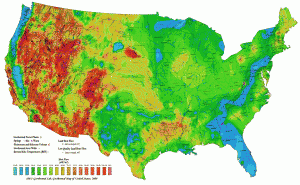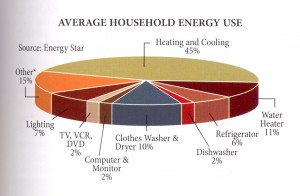This requires looking at any building as an integrated system and understanding how the various components impact each other. The best trained HVAC contractors have been doing that very analysis for decades. At AirWorks, Heating and Cooling Professionals has been designing, installing, and servicing home and business mechanical systems in the Flathead Valley for 15 years in accordance with the best practices developed by ACCA (Air Conditioning Contractors of America) and endorsed by the EPA and DOE. Quite simply, AirWorks “creates healthier, energy saving, indoor climates” by controlling temperatures, air pressures, fresh air, and humidity. As a performance based contractor they are equipped to test and quantify your home for its energy efficiency using combustion analyzers, blower door, and duct blasting diagnostic tools. All components of your home have either a resistance to heat flow (example: insulation) or conductivity (example: concrete walls). There are numbers associated to the heat flow through any of these building components such as windows, doors, ceilings, floors, walls, and fireplaces. A thorough inventory of the number and size of these components, including orientation, must be taken. These values are then entered into a specialized computer program to determine equipment sizing and energy modeling. The blower door test is useful in quantifying how much air leaks into the home through gaps and penetrations in the building envelope. This is another important input for the software. The output of the program is the heat load calculation. This data is required for the HVAC contractor to properly “size” and design a mechanical system that meets the physical requirements of the structure and the life style impacts of the homeowners. Between the heat load calculation, the architectural design, and homeowner needs (including budget) AirWorks can determine what type of equipment, distribution, and control methods will most completely create an efficient and healthy mechanical design. If one word best describes the current offering of heating and cooling products, that would be innovative. Our industry has seen amazing improvements across the board as manufactures strive for higher and higher efficiencies. Computer based controls can now “learn” to increase performance. Many new alloys, stainless steel and thermoplastics have been used to create durable lightweight equipment. Newer refrigerants and improved heat exchanger designs have dramatically improved capacities and efficiency. What all this means for the consumer is a broad spectrum of products that when properly applied, will make one more comfortable and save energy. AirWorks Inc. has been involved in every facet of HVAC in the last 15 years, but the current thrust has been heat pumps technology. This is being driven by customer demand which is being accelerated by numerous federal and state tax incentives, utility rebates, and the desire for the lowest operating cost possible. Even without the incentives they are attractive, but the kick back money makes the decision to do the right thing easier. There are three major design concepts in modern heat pumps: air-to-air, ductless, and geothermal. When doing research on heat pumps, understanding the nuts and bolts is not as important as proper application of the technology. MODERN HEAT DESIGN AirWorks specializes in doing the calculations to ensure the right fit for maximizing performance. Analyzing the homes heat loss, current operating costs, available budget, and payback periods will help determine the best system design. A careful consideration of these various factors will help ensure the best outcome for the money invested. Air-to-air heat pumps consist of an outdoor unit much like a standard A/C unit. They are designed to absorb heat from the outside air and reject that heat into the home. There is an incredible amount of heat energy contained in the relatively cool outside air. This energy is absorbed and concentrated through the refrigeration process to provide very efficient heating in all but the very coldest outside temperatures. Typically this heat is distributed through ducting and this technology can be easily combined with fossil fuels such as propane and natural gas. A standard installation would be adding an air-to-air heat pump to an existing gas furnace. This allows the heat pump to provide the majority of the heat at greater efficiency, and as the outside temperature approaches zero, the gas furnace takes over. This design is called “Dual Fuel” and takes advantage of the heat pumps most effective temperature range and gas furnaces run more efficiently at colder “steady state” operation. AirWorks now offers a system that can be powered by solar panels. In fact, up to twelve solar panels can be installed to deliver excess power through the heat pump back to ones electrical panel to actually turn the meter backwards. This comes with computer monitoring software that continuously reports the effectiveness of the solar panels. Ductless heat pumps are a type of air-to-air heat pump that do not require duct work. If one has visited Europe or Asia you would have certainly seen them. The distribution of heat or cooling in these systems is done by a small evaporator unit(s) mounted on inside walls with connecting refrigerant lines and wiring to a remote outside condensing unit. The noise level is almost inaudible in most modes of operation. Automatic dampers slowly oscillate providing uniform comfort by reducing air temperature stratification in the room. Built-in air cleaners wash the air as it is being heated or cooled. The visibility of the indoor unit is the only objection to this type of system. However, they do blend in quite well and there is the option to use a concealed indoor unit hidden above a closet. Multiple indoor units can be connected to a single outdoor unit. This flexibility allows these systems to condition the whole home or only specific zones or areas.
This makes heat extraction much easier even in the coldest above ground temperatures, unlike an air-to-air heat pump. Heat is absorbed from the ground in two ways. A closed loop system consists of a series of polyethylene tubes that circulate water treated with antifreeze. This water absorbs the ground heat and delivers it to the indoor heat pump unit for concentration and distribution to the home. Ground loops can be installed vertically or horizontally. Soil type is critical to effective heat transfer, so knowing the geology is critical and may mean that geothermal is not a viable option. Moist loamy soils are best suited. Horizontal drilling has been a game changer where ground loops are concerned. A utility drill is used to bore under your property well below landscaping, outbuildings, trees, and driveways. The plastic tubing is then pulled back to the home with minimal surface ground breaking. The other way to extract the ground heat is with an open system, which utilizes well water. Ground water is pumped through the heat exchanger of the heat pump, removing 6-8 degrees of heat and discharging that water into a reinjection well. Open looped systems are less costly to install up front because they do not require excavation or great coils of piping. But again proper geology is important. Water temperature and pressure is critical to a successful application. Geothermal technology can be added to most existing radiant floor systems and forced air systems to vastly reduce operating costs. Whether you are thinking of building a new home or remodeling an existing gem, AirWorks has the tools and expertise to test and verify the thermal efficiency of the building and mechanical systems. At AirWorks, lowering operational costs while improving comfort and air quality is the highest priority. For more information call AirWorks, Inc. at 406. 257.1341 |
[bannergarden id=”7″] |
| [bannergarden id=”8″] | |
| [bannergarden id=”9″] |

